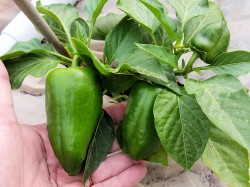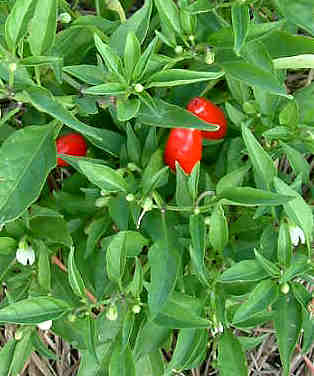Peppers in the Garden
So what’s new with the peppers in the garden? We’ve had a cold winter here in South Florida, which has affected the peppers (sweet and chile). However, the days are warming, and hopefully we won’t have any more nights in the 30’s!
So what’s with the peppers in the garden — and what about another pepper germination update? Here goes!
What’s in the Garden?
The biggest plant by far is my (oldest) jalapeno. Even though I have it growing in a 5-gallon container, it looks pretty happy, and already I see tiny peppers being born!
The plant most unhappy is a tie between my Thai Hot and a generic yellow bell. Both have gone through some mighty cold weather that the jalapeno didn’t, and they are both showing stress. However, the yellow bell does have one pepper on it, and it starting to sprout more leaves, so maybe it’s turning the corner. The Thai Hot has had a lot of flowers, but so far no peppers.
Some of the peppers that are just humming right along are Anconcagua, Park’s Whopper (a sweet banana type) and Corno di Toro. Also doing well are Pretty Purple Pepper and Purira (both chile peppers).
What’s in Staging?
My staging area is for plants that are too big to be inside anymore, but still a little too small to be in the garden proper. I have them in 1-gallon pots in a spot that gets about 6 hours of sun a day.
So here’s what’s in staging:
- Bhut Jolokia (one of the hottest pepper in the world).
- Cambuci Hot (2)
- Sweet Pickle (1)
- Redskin (2)
- Nardello Sweet (2)
- Mini Belle (2)
I had two Bhut Jolokia plants, but one of them I think I put out in staging a little too soon — it kind of melted away. The larger of the two seedlings seems to be doing fine, though.
Waiting in the Wings
I have a few more Redskin, Sweet Pickle and one Mustard Habanero. For some reason, the other one failed to “take” after it sprouted. This one waiting in the wings has taken it’s own sweet time, and it will still be another week or two away from moving out to staging.
If you’re wondering about the Peter Pepper I mentioned in my last report, alas, the peppers didn’t make it. They sprouted, but never grew strong enough to shake off the seed coat. I’ll try again sometime later this year.
Upcoming Chile Peppers
I’ve got some more chili pepper seeds that I’ll be planting over the next few weeks. They include:
- Datil
- Fish Pepper
- Early Scotch Bonnet
- Aurora
- Purple Jalapeno
- Jaloro (a yellow jalapeno)
Still debating on if I should plant some Starburst, Medusa and Riot. All three are chile peppers, but more ornamental than for eating. I probably will, seeing as the front garden (which faces the street) could use some color.
I’ll go out and take some photos in the next week, so you can see how pretty the large jalapeno is. Pretty Purple Pepper is also neat, as it has varigated foliage.
Meanwhile — gotta take care of the peppers! Which brings me to ask — what are you growing, or planning to grow?
Germinating Pepper Seeds, Update
It’s been just over a week since I planted my latest batch of pepper seeds, both hot and sweet. So what’s sprouting already?
And the Winner Is…
Corno di Toro, a sweet pepper, was first out of the gate at 5 days. However, of the two seeds I’ve planted, only one has shown up yet. On the other hand, I planted two different strains (confused yet?). At any rate, the red Corno di Toro is the clear winner.
Jalapeno M was the second to sprout at 6 days, with both seeds coming on up. Jalapeno M was closely followed by Cambuci Hot, about a half day behind.
The next two sprouted at nearly the same time — Nardello Sweet and Mini Belle.
And finally this morning — Mustard Habanero. Wow, a super-hot pepper in 7.5 days — amazing.
I’m Waiting On
Some “hotties” — Hot-Banero, Peter Pepper and Bhut Jolokia. Also lagging are two more jalapenos — Jaloro and Tam Jalapeno. Brazillian Rainbow is also nowhere to be seen yet. I know — patience! And considering 10 to 21 days is the usual for hot chile peppers, it’s great that some have already shown their faces (er, leaves). Yes, the seed germination mat I talked about does work well, shaving days off the sprouting.
Thinking About a Transplant
Purira pepper (quite hot) is growing very strong and looks like it will need its final transplant before going outside to harden off for the garden in the next few days. Seeing as I did its first transplant early last week, this one appears to be a winner!
Other pepper seeds that need their final transplants before hardening off include Redskin, Anconcagua and the last of the sweet banana peppers. For Sweet Pickle I just did its first transplant on Saturday, and it appears that it will need its second transplant this weekend — wow, that was fast!
More Seeds?
I think I’ll take a short break, since I have at least 20 pepper plants at the moment, not counting the ones that are just now sprouting. Come the middle of April, it will be time to start thinking about my late Summer wave. I’m planning on the following peppers for then: Datil, Tennessee Teardrop, Ring of Fire, Yellow Cayenne and Scotch Bonnet. On the cooler side it will be more Sweet Banana, along with Anconcagua and probably Nardello Sweet. Perhaps Mini Belle again, if small bell peppers work well for me.
Have You Planted Your Seeds Yet?
I know, it’s been a cold winter, and for many of you, putting pepper plants into the garden is many months away. But for you folks in zones 8, 9 and 10 — it’s pepper “prime time”. Get planting!
P.S. — it’s a few hours later and both my Corno di Toro, both Cambuci and both Mustard Habaneros are up. Even Peter Pepper is starting to break through! What a difference a few hours can make. 🙂
How Long Do Pepper Plants Live?
How long do pepper plants live, anyway? Are they annuals, perennials or somewhere in between? Can you grow them indoors in the winter? Let’s take a look at the life of a pepper plant.
Note: In the years since I have written this post I have had more experiences with keeping pepper plants going — here’s my new post. (Read this one first, though, because it has additional information.)
Pepper Types (Species)
There are five main species of peppers:
- Capsicum annuum:Â Includes bell, sweet and many standard chile peppers like ancho, jalapeno, cayenne and more.
- Capsicum chinense:Â Includes datil, habanero and scotch bonnet peppers.
- Capsicum frutescens:Â Includes tabasco and thai peppers.
- Capsicum pubescens:Â Includes the South American rocoto peppers.
- Capsicum baccatum:Â Includes the aji peppers.
It’s important to know the species, as some are longer-lived than others. All pepper plants can be grown as annuals, but a few species can be perennial, provided they are in very warm, tropical climates.
There’s one pepper that seems to be cross-species, and that is the naga / bhut jolokia pepper. Originally called Capsicum frutescens, DNA testing has found some Capsicum chinense genes as well.
Capsicum Chinense as a Perennial
The Capsicum chinense peppers can live several years, providing they are in a warm climate. In theory, this means you can grow this species in a warm greenhouse as a perennial.
I’ve grown habaneros almost perennially here in South Florida, but I’m afraid that some of our cold snaps have done them in. This year I am trying habaneros and datils in containers, so that I can move them into the house (well, garage at any rate) when the temperatures fall below 45 degrees.
Capsicum Annuum
Your average pepper plant belonging to the species Capsicum annuum is generally grown as an annual. Although I have had some pretty long-lived jalapenos, they eventually get woody and die off.
I’ve never tried pruning a jalapeno, though, to see if I can revitalize it — that’s something I’ll have to try this year.
Although you really can’t grow them as a true perennial, Capsicum annuum can have an extended season. If you’re growing your pepper(s) in a container, you can try moving them indoors when the weather cools down. Just keep in mind that your pepper still needs plenty of sunlight; without sunlight, all the warmth in the world won’t extend your pepper’s life. That may mean a combination of south-facing window along with some supplemental light (grow lights).
Other Pepper Species
The same general rules apply to the other species; they need warmth and plenty of sunlight in order to keep growing. In their native tropical environments, the plants can live multiple years. But even in South Florida, they won’t necessarily live all year around — we do get chilly weather, and even as I write this, I’m expecting freezing temperatures tomorrow night.
So how long do pepper plants live? While they may not be perennial in the sense of living years on end, there are varieties that can grow several years — if you have the right climate.
Additional Reading
You might enjoy these related posts on peppers: